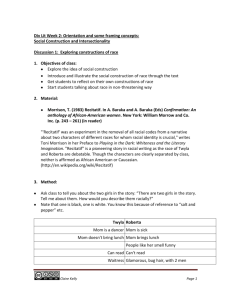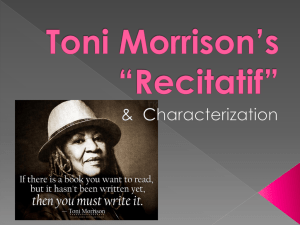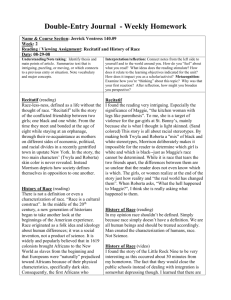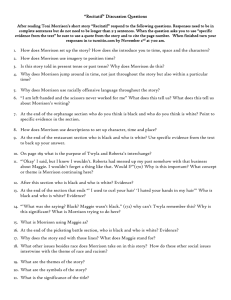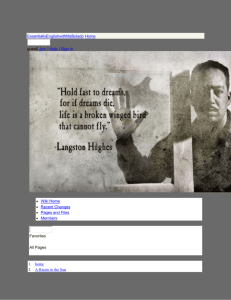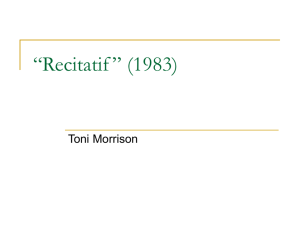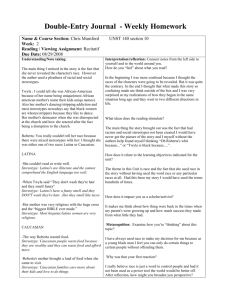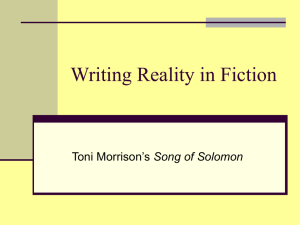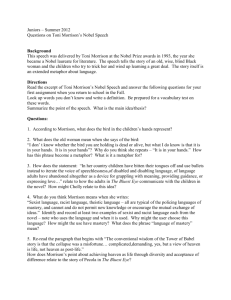Recitatif
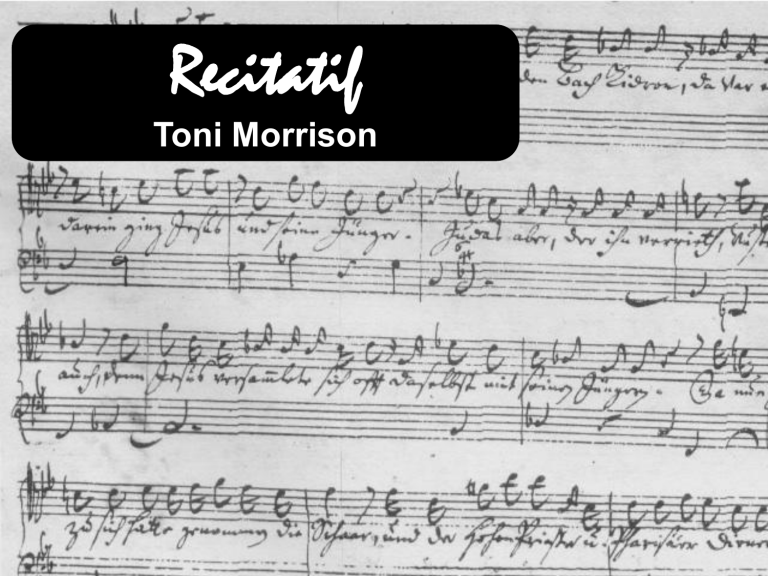
Recitatif
Toni Morrison
Toni Morrison: Nobel Prize Recipient
Toni Morrison was born Chloe
Anthony Wofford to George
“If there’s a book and Rahmah Wofford in 1931.
The second of four children, that you want to read, but it hasn’t
Morrison was raised in the small Ohio town of Lorain in a tight-knit black community.
Morrison describes her father, been written yet, then you must write it.” – Toni a shipyard welder, as a racist.
Morrison
Having experienced virulent racism, he despised whites. Her mother, on the other hand, was an integrationist. Both of her parents and her larger community instilled in Morrison a strong sense of self-esteem and cultural identity.
Morrison’s writing career began at age 30 when, feeling unfulfilled, she joined an informal writer’s group. Morrison drafted a short story about a black girl who wished she had blue eyes. She had never written fiction or poetry before. This story was the seed of her first novel, The Bluest Eye , which she published nine years later. Since then, she has authored nine additional novels, two plays, and a work of literary criticism. ‘‘Recititaf’’ is her only published work of short fiction. Since 1987 she has focused mainly on writing but has also taught classes at Yale and Princeton Universities.
Toni Morrison
The Nobel Prize for Literature Jury awarded the prize to Morrison, “who in novels characterized by visionary force and poetic import, gives life to an essential aspect of American reality.”
Genre: Novel, short story, play
Movement: Postmodernism
Major Awards:
Pulitzer Prize (1988)
Nobel Prize for Literature (1993)
Novels:
1.
The Bluest Eyes (1970)
2.
Sula (1974)
3.
Song of Solomon (1977)
4.
Tar Baby (1981)
5.
Beloved (1988)
6.
Jazz (1992)
7.
Paradise (1997)
8.
Love (2003)
9.
A Mercy (2008)
10.
Home (2012)
Short Story:
“Recitatif” (1983)
Plays:
1.
Dreaming Emmett (1986)
2.
Desdemona (2011)
Historical Context:
Race Relations in the 1950s (Segregation)
In the 1950s communities throughout the country, particularly in the South, had segregated public facilities, including schools, public transportation, and restaurants. Throughout the country, social and cultural segregation was the norm. There were several landmark events in the struggle for racial equality during this decade and it is considered to mark the beginning of the Civil
Rights Movement. In 1954, overturning a 1896 decision, the Supreme Court ruled that segregated schools were unconstitutional, though integration would occur gradually. The decision was met with strong resistance from politicians and the public alike. The state government of Arkansas defied the
Supreme Court and attempted to prevent black children from entering and integrating the Little Rock public schools. Blacks became organized around other forms of segregation as well. In 1956 Rosa Parks, a middle-aged seamstress, refused to give up her seat on a Birmingham, Alabama, bus for a white commuter, igniting a year-long bus boycott. Martin Luther King, Jr., emerged as the leader of the movement.
Historical Context:
Race Relations in the 1960s (Civil Rights Activism)
Blacks began to stage ‘‘sit-ins’’ at white lunch counters and restaurants across the South in protest of segregation. Northern students, radicalized by their opposition to the Vietnam War, joined the Civil Rights Movement in greater numbers, participating in marches and voter registration drives. More middleclass whites became enamored of black culture, and more blacks became aware of their African roots. Organized demonstrations were planned, with both black and white student activists participating in ‘‘freedom rides’’ to the
South in protest of segregated interstate public transportation policies.
Martin Luther King rose to national prominence, promoting a philosophy of nonviolence. A number of activists, both black and white, were killed as a result of their positions, and King himself was assassinated in 1968. King’s death led to intense disillusionment among many, followed by greater divisiveness among activists, the rise of Black Power separatism, and renunciation in some quarters of the nonviolent approach.
Historical Context:
Race Relations in the 1970s (Busing)
While much of the racial conflict of the 1960s took place in the South,
Northern cities became more of a flashpoint in the Civil Rights strife of the
1970s. Economic strain and police brutality contributed to race riots in a number of cities, which alienated some white activists. One of the most significant triggers to racial tension in the North was the institution of busing to ensure the desegregation of schools. 1971 marked the beginning of courtordered school busing. Courts declared that ‘‘de facto’’ segregation existed in many northern urban school districts and found it to be illegal. This meant that the courts found Northern schools to be effectively segregated due to the existing racial mix in many school districts and neighborhoods, and that children must be bused out of their neighborhoods in order to ensure a fair access to educational resources. Busing ignited protests and outbreaks of violence in many communities. In the same time period, many blacks began to benefit from more equitable laws, entering politics and other positions of power in unprecedented numbers.
Social Context
The chaotic events of the 1960s, including war and social change, seemed destined to continue in the 1970s and even in the 1980s. Major trends included a growing disillusionment with government, advances in civil rights, and increased influence of the women's movement.
Disillusionment with government
In the aftermath of the Vietnam Conflict, many young people believed that their government had lied to them. Consequently, a majority of them began to question anyone in authority.
Civil rights
People of color were no longer content to be shut out from the mainstream of
American life. They also began celebrating their diversity, both ethnically and culturally.
Feminism
The role of women was profoundly altered, as many women came to see themselves as equals, legally, socially and sexually, with men. In growing numbers, they entered university to obtain degrees in traditionally male disciplines. Unlike their mothers, most women chose to remain in the work force after marriage. Many believed only they had the right to control their bodies, whether in context of abortions or sexual freedom.
Literary Context
‘‘Recitatif’’ was published in a 1983 anthology of writings by African-American women entitled Confirmation . The purpose of the anthology – edited by Amiri
Baraka, one of the most prominent voices of the radical Black Arts Movement of the 1960s, and his wife Amina – was to confirm the existence of several generations of black female writers whose work was often ignored or undervalued. The Confirmation anthology marked the beginning of a period when an unprecedented number of black women writers – Alice Walker,
Jamaica Kincaid, Gloria Naylor, and Morrison among them – rose to prominence and ‘‘crossed over’’ for commercial success among a mostly white reading public.
A common theme – not just in works by African-American writers – was a search for identity.
Postmodernism Literary Movement
The year 1941 is generally regarded as the start of the Postmodern
Literary Movement. A notoriously ambiguous term, especially as it refers to literature, Postmodernism can be seen as a response to the elitism of high modernism as well as to the horrors of World War II. Postmodern literature is characterized by a disjointed, fragmented pastiche of high and low culture that reflects the absence of tradition and structure in a world driven by technology and consumerism. Julian Barnes, Don DeLillo, Toni
Morrison, Vladimir Nabokov, Thomas Pynchon, Salman Rushdie, and Kurt
Vonnegut are among many who are considered Postmodern authors.
Recitatif
Recitatif
Characters
• Twyla Benson – The protagonist and narrator of the story who was placed in an orphanage because her mother chose or needed to “dance all night”
• Roberta Fisk Norton – A major character and Twyla’s friend who was placed in the same orphanage as Twyla because her mother is too ill to care for her
• Maggie – A racially ambiguous kitchen worker in the orphanage
• Big Bozo/Mrs. Itkin – Caretaker at the orphanage
• Mary – Twyla’s affectionate and pretty yet neglectful and irresponsible mother
• Roberta’s mother – Roberta’s sick, religious, racist mother
• James Benson – Twyla’s husband
• Joseph Benson – Twyla’s son
Recitatif
Style
The title alludes to a style of musical declamation that hovers between song and ordinary speech; it is used for dialogic and narrative interludes during operas and oratories. The term "recitatif" also once included the now-obsolete meaning,
"the tone or rhythm peculiar to any language."
Both of these definitions suggest the story's episodic nature, how each of the story's five sections happens in a register that is different from the respective ordinary lives of its two central characters, Roberta and Twyla. The story's vignettes bring together the rhythms of two lives for five, short moments, all of them narrated in Twyla's voice. The story is, then, in several ways, Twyla's "recitatif."
This story is divided into five rather distinct sections which help emphasize the relationships between the two central characters.
Recitatif
Setting
1.
St. Bonaventure Orphanage (St.
Bonny’s)
2.
Eight years later in a Howard Johnson restaurant
3.
Twenty years later from initial meeting; in the Food Emporium
4.
Outside a school in Newburgh, NY
5.
In a coffee shop on Christmas Eve
(probably in the 1980s)
Recitatif
Conflict
• External - Man vs. Man
1. Racial
2. Economic
3. Hierarchial a.
Apple orchard b.
Outside school in Newburgh
• Internal - Man vs. Self
Search for truth
Recitatif
Symbolism
• St. Bonaventure
• Food
• Apple orchard
• Character of Maggie
1.
Companionship
2.
Conflict
3.
Similarities/differences
Recitatif
Irony
Twyla’s mother’s name (Mary)
Recitatif
Themes
• Racism
• Identity
• Friendship
